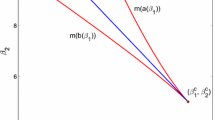Abstract
The exponential family of random graphs is one of the most promising class of network models. Dependence between the random edges is defined through certain finite subgraphs, analogous to the use of potential energy to provide dependence between particle states in a grand canonical ensemble of statistical physics. By adjusting the specific values of these subgraph densities, one can analyze the influence of various local features on the global structure of the network. Loosely put, a phase transition occurs when a singularity arises in the limiting free energy density, as it is the generating function for the limiting expectations of all thermodynamic observables. We derive the full phase diagram for a large family of 3-parameter exponential random graph models with attraction and show that they all consist of a first order surface phase transition bordered by a second order critical curve.








Similar content being viewed by others
References
Besag, J.: Statistical analysis of non-lattice data. J. R. Stat. Soc., Ser. D, Stat. 24, 179–195 (1975)
Hammersley, J., Clifford, P.: Markov fields on finite graphs and lattices (1971). http://www.statslab.cam.ac.uk/~grg/books/hammfest/hamm-cliff.pdf
Holland, P., Leinhardt, S.: An exponential family of probability distributions for directed graphs. J. Am. Stat. Assoc. 76, 33–50 (1981)
Frank, O., Strauss, D.: Markov graphs. J. Am. Stat. Assoc. 81, 832–842 (1986)
Snijders, T., Pattison, P., Robins, G., Handcock, M.: New specifications for exponential random graph models. Sociol. Method. 36, 99–153 (2006)
Rinaldo, A., Fienberg, S., Zhou, Y.: On the geometry of discrete exponential families with application to exponential random graph models. Electron. J. Stat. 3, 446–484 (2009)
Wasserman, S., Faust, K.: Social Network Analysis: Methods and Applications. Cambridge University Press, Cambridge (2010)
Chatterjee, S., Diaconis, P.: Estimating and understanding exponential random graph models (2011). arXiv:1102.2650v3
Yang, C.N., Lee, T.D.: Statistical theory of equations of state and phase transitions. Phys. Rev. 87, 404–419 (1952)
Erdős, P., Rényi, A.: On the evolution of random graphs. Publ. Math. Inst. Hung. Acad. Sci. 5, 17–61 (1960)
Park, J., Newman, M.: Solution of the two-star model of a network. Phys. Rev. E 70, 066146 (2004)
Park, J., Newman, M.: Solution for the properties of a clustered network. Phys. Rev. E 72, 026136 (2005)
Lovász, L., Szegedy, B.: Limits of dense graph sequences. J. Comb. Theory, Ser. B 98, 933–957 (2006)
Häggström, O., Jonasson, J.: Phase transition in the random triangle model. J. Appl. Probab. 36, 1101–1115 (1999)
Bhamidi, S., Bresler, G., Sly, A.: Mixing time of exponential random graphs. Ann. Appl. Probab. 21, 2146–2170 (2011)
Radin, C., Yin, M.: Phase transitions in exponential random graphs (2011). arXiv:1108.0649v2
Aristoff, D., Radin, C.: Emergent structures in large networks (2011). arXiv:1110.1912v1
Yin, M.: Understanding exponential random graph models (2012). http://www.ma.utexas.edu/users/myin/Talk.pdf
Krantz, S., Parks, H.: The Implicit Function Theorem: History, Theory, and Applications. Birkhäuser, Boston (2002)
Acknowledgements
The author gratefully acknowledges the support of the National Science Foundation through two international travel grants, which enabled her to attend the 8th World Congress on Probability and Statistics and the 17th International Congress on Mathematical Physics, where she had the opportunity to discuss this work. She is also thankful to the anonymous referees for their useful comments and suggestions.
Author information
Authors and Affiliations
Corresponding author
Additional information
Mei Yin’s research was partially supported by NSF grant DMS-1308333.
Rights and permissions
About this article
Cite this article
Yin, M. Critical Phenomena in Exponential Random Graphs. J Stat Phys 153, 1008–1021 (2013). https://doi.org/10.1007/s10955-013-0874-x
Received:
Accepted:
Published:
Issue Date:
DOI: https://doi.org/10.1007/s10955-013-0874-x



